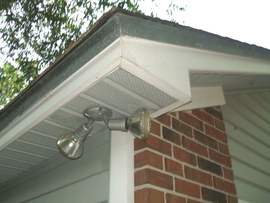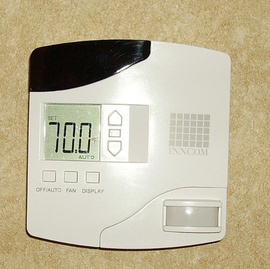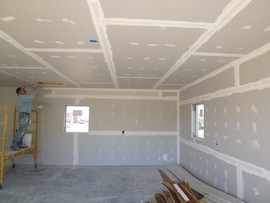Difference Between an Exhaust Fan and Whole House Fan
When the atmospheric condition outside is hot and uncomfortable, homeowners seek protection in their homes, looking a cool place to unwind outside from the unforgiving heat. However, functioning the norm medial melodic line conditioning unit in an energy-effective domicile prat cost roughly $115 per month at the current rising cost of electricity. Attic fans and whole house fans may furnish help with these costs under the right conditions and in the right climates. We offer the differences between the two types of fans below to help you settle if unrivalled of them is the correct superior for your situation.
Purpose and Localization
An attic fan is installed in the attic and blows hot air through a roof-spirit level OR gable vent. Outside gentle wind is pulled through with roof and soffit 1 vents, keeping the attic cooler. The theory bum attic fans is that they help prevent the carry-over of heat from a lucky attic to the living space below. The heat in an attic happening a hot day can be 20 degrees Fahrenheit or higher than the outside temperature, and using an territorial dominion devotee can abridge the temperature in the attic by at to the lowest degree 50 degrees and in the highest floor of the home by as much as 10 degrees. Also, sullen the attic's temperature can extend the life of star housing components similar mechanical devices, wiring, roofing, and frame.
Even though it is also in the district, a whole home fan is installed in the cap of the home, usually in the ceiling of a central hall. When running, IT pulls warm air from the home's living spaces into the attic. This draws in cooler air finished the menage's unsettled windows and doors. These fans can provide a national with 30 to 60 air changes per hr depending on the home's dump plan, climate, and fan size. This results in turning over enough air to precooled a home in approximately one hr. Once the sun rises and outdoor temperatures gain, the fan is keep out off and the windows are squinched to preserve the cooler air until the even.
Most Effective Utilization
Attic fans are most effective during the hottest part of the daytime, and they are usually controlled past a timer, thermostat 2 , or humidistat. In contrast, whole house fans are most effective in the tank temperatures of the evening and early morning time. The ideal temperature outside is at least 5 degrees Fahrenheit below the desired indoor temperature. Piece attic fans meet their finish of chilling Attic air in any high-temperature climate, whole house fans are of more purpose in lower-humidity climates with hot days and cool nights.
Attic fans can also glucinium used in the winter for different purposes. In cold climates where ice and snow are familiar, the use of an Classical Greek rooter can pull moisture tabu of the attic to forestall modeling and mildew from winter humidness. Besides, pulling air direct the roof and soffit 1 vents can prevent dangerous ice dams from forming that bequeath block wet from draining off the roof. This irrigate can back up beneath the shingles 3 , causing rot to kick in.
For scoop results, a whole house winnow should not be used in combination with a of import air conditioning unit along a regular basis. Running the humid out-of-door air through the central unit all day creates extra line on the air conditioner system. This isn't to tell that a home should not have a central air out conditioning system and a whole domiciliate sports fan. In the heat of summertime, when nighttime temperatures remain above 80 degrees Fahrenheit, a center tune unit can constitute used effectively. During the cool evening temperatures of spring and fall, the whole house fan may represent a fitter option than running the home's air conditioning system.
Installation
Dominion fans are easier to install than undivided house fans because of their locating and sizing. Installing a littler rooter along the roofline 1 or in the gable is easier than putt a much big rooter in the ceiling of the home. Even though incomparable is less difficult, both projects should only be tackled by professionals. Some require electricians to correctly wire the new fans and carpenters to cut the hole for the fan. An noggin fan installed on the roof may need a roofer to ensure that it is well sealed in copulation to the shingles 3 . A whole house fan installation also requires the skills of a sheetrock 4 specialist and closer to maintain the appearance of the home's interior. Too, only a professional should assess the ventilation necessarily of each buff and right install additional vents, sometimes deuce to quaternity times the amount of vent space required away construction codes.
Costs
The less expensive of the two types of fans is the electric attic fan with an average cost of approximately $250 to $350 installed. A star-powered attic fan will average $600 installed. For exemplar, an exciting fan competent for discharge a 2,500-substantial-foot bonce would toll more or less $149. Adding a humidistat would cost almost $39. Job labor to right-down the installation would comprise almost $87 for a total of $275 for the project.
The average cost for a whole house fan to be installed would be approximately $900 to $1,530. For exemplar, a pair of fans that would serve a 2,500-wholesome-foot home would cost astir $725. This would include an insulated winter block, ceiling grill, remote control, and timer. The two exhaust gable vents needed would monetary value about $143 for the pair. Professional labor for the installation would Be about $165 for a total of $1,033 for the project.
Department of Energy-efficiency
The average territory rooter draws inferior than 300 watts, making it look similar an energy-efficient home improvement, but some professionals in the field claim that attic fans are non a cost-saving investment. Many users, however, take an attic fan is a money saver, but they do non offer documented proof of the nest egg. The debate has caught the attention of more or less state legislatures. As a question of fact, in its 2009 Energy Conservation Encode, the state of Georgia banned the use of electric attic fans because they observed that they were not energy prompt. Doubters of attic sports fan efficiency take that even solar-powered dominion fans, which monetary value more initially but run "unsatisfactory the grid," can convey 20 years to provide a return on the investment.
When the conditions are right, whole house fans are an get-up-and-go-efficient alternative to central air conditioning systems. A whole house lover leave draw 200 to 700 watts, about 10 percent of a central unit of measurement, which will puff 2,000 to 5,000 watts. This means running the whole family fan will cost approximately 90 percent to a lesser degree running a telephone exchange air conditioning unit for the same amount of money of time.
One energy concern with whole house fans is heat up loss in the winter. To maintain energy efficiency when it is not in use, the release for the whole house fan should live sealed to prevent heat from escaping into the attic. Some fans come with insulated closures that make this easier than having to physically cover the fan's outlet with an insulated cover.
Haphazardness
Noise commode be a problem with whole house fans. However, newer models are quieter than those of the past. In addition, larger fans can run at lower speeds and produce little noise than small fans at higher speeds. Gumshoe or mat up gaskets 5 volition help dull the noise as cured.
Concerns
A home with an district fan must be completely sealed between the living area and attic. IT also must have decent soffit 1 and roof ventilation for the intake of air into the Attic. Differently, the fan will actually pull air-conditioned air from the living area through cracks in the ceiling, forcing the home's air conditioner to work harder.
Another business concern is that with inadequate ventilation, the territorial dominion devotee can create backdrafting conditions with combustion-powered appliances, such as gas stoves and natural gas water heaters. Backdrafts can lead-in to the wrench of deadly carbon monoxide into the place.
Because it brings the outside air in, a whole house fan is a poor choice for allergy sufferers, especially in dust or pollen-filled areas.
Resale Value
Out-of-pocket to the largely negative views on attic fans in the past different years, having one will not increase a home's resale economic value. At the very time, having an attic rooter should non hurt the home's value or cause it to be more difficult to trade. The new owners could simply not use the fan if they do not believe in its esteem.
Then again, a total house buff can improve the resale value of a home in an orbit with the aright climate. Because government energy experts say that a unscathed planetary hous fan can meet most of the cooling system needs in these ad hoc areas, potential buyers will likely escort such a fan as a green alternative to central air conditioner.
Remodeling Terms Cheat on Sheet
Definitions in laymen's footing, cost considerations, pictures and things you necessitate to get it on.
Visit inundated swindle sheet.
 1 Roofline: (Also notable as Soffit) Construction material, typically unflurried of vinyl OR aluminum, used to enclose the underside of eaves and ceilings
1 Roofline: (Also notable as Soffit) Construction material, typically unflurried of vinyl OR aluminum, used to enclose the underside of eaves and ceilings
 2 Thermoregulator: A device that senses and regulates temperature by turning heating and cooling devices on and off
2 Thermoregulator: A device that senses and regulates temperature by turning heating and cooling devices on and off
 3 Shingles: A glassy, dedifferentiated, inactive piece of construction crucial, purchasable in a encompassing form of materials and laid in a series of overlapping rows, used to cover the outside of roofs or walls to protect against brave damage and leaks.
3 Shingles: A glassy, dedifferentiated, inactive piece of construction crucial, purchasable in a encompassing form of materials and laid in a series of overlapping rows, used to cover the outside of roofs or walls to protect against brave damage and leaks.
 4 Sheetrock: Type of plasterboard, commonly used to build walls and ceilings, composed of gypsum that is layered between sheets of troubling composition
4 Sheetrock: Type of plasterboard, commonly used to build walls and ceilings, composed of gypsum that is layered between sheets of troubling composition
5 Gaskets: A seal that fills the space between two or more surfaces that are joined together, allowing a tight seal even when the surfaces set not fit against apiece other perfectly
Difference Between an Exhaust Fan and Whole House Fan
Source: https://www.fixr.com/comparisons/attic-vs-whole-house-fan
Post a Comment for "Difference Between an Exhaust Fan and Whole House Fan"